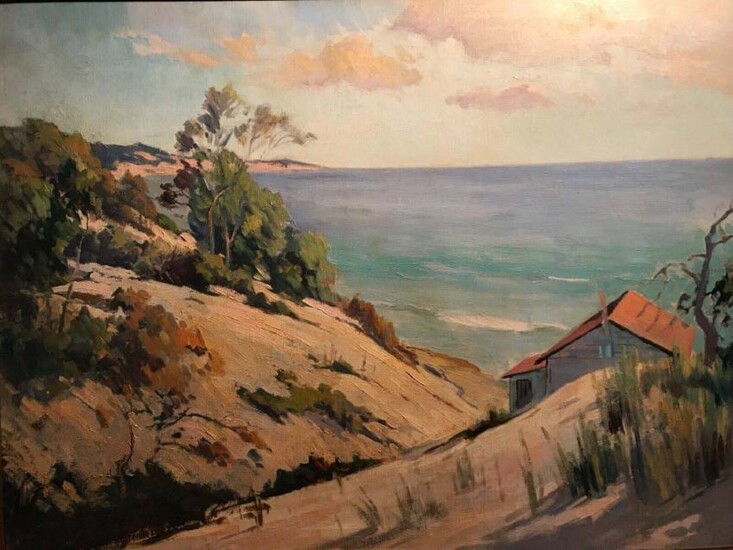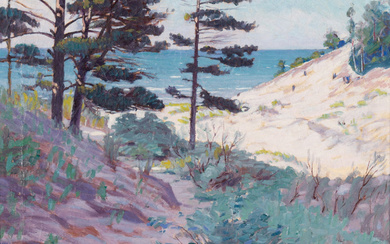FRANK VIRGIL DUDLEY INDIANA DUNES OIL ON CANVAS
FRANK VIRGIL DUDLEY INDIANA DUNES OIL ON CANVAS PAINTING POSS. LAKE VISTA
DETAILS:
- ARTIST: Frank Virgil Dudley
- ORIGIN: American, (1868-1957)
- TITLE: Indiana Dunes, Poss. Lake Vista
- SIGNED: Unsigned
- MEDIUM: Oil on Canvas
- SIZE: 30 x 40 In. (artwork) / 33-1/2 x 43-1/2 In (framed).
- CONDITION: Very good to excellent.
- ADDITIONAL NOTES: Housed in its original hand carved gilt wood frame. This magnificent (large format) work depicts either Lake Vista or Mount Tom. – Indiana.
- FWIW: Christie’s New York: 10/18/1989 lot# 284 sold an un-signed large format work by Frank Virgil Dudley measuring 45 x 60 inches. Sold: $4,192.00 USD against a pre-sale estimate of 3,000-5,000 USD
ARTIST BIO:
Frank Virgil Dudley was known as the 'Painter of the Dunes,' because of his fascination with the Indiana dunes on Lake Michigan, beginning with his first visit in 1911 to the area when he was hiking with the Prairie Club of Chicago. This organization was one of the 'contemporary manifestations of a burgeoning spirit of regional identity that championed local cultural expression and the appreciation and preservation of the local landscape.' (Greenhouse, 96)
In 1916, Dudley decided to focus on the Indiana Dunes as his primary subject matter. In 1918, thirty of his paintings were featured in a Chicago Art Institute exhibit, 'Western Scenes', which was co-sponsored by three other clubs also devoted to conservation: Friends of Our Native Landscape, the Dunes Pageant Association and the Conservation Council. Reportedly, many viewers were greatly surprised that the dune paintings reflected scenes of unspoiled beauty from Indiana, their own region, rather than more 'exotic' places in the United States, East and West.
Dudley, born in Delavan, Wisconsin, had worked as a youth with his father as a house painter. Frank was one of three brothers born to deaf-mute parents, James A. and Flora Virgil Dudley. Communicating in sign language, James Dudley taught his sons the craft of house painting. James also had some skill as a draftsman and easel painter, and Frank likely received his earliest art instruction from his father. He also studied easel painting with Albert McCoy, who was a visiting artist from Chicago, and then moved to Chicago where he took a job as a commercial engraver. He attended night classes at the Art Institute where he studied under John H. Vanderpoel and Charles Boutwood. Around this time he also had an introduction to Impressionism by way of the 1893 World's Columbian Exposition in Chicago.
Frank married Mahala Boxwell several years before their son Paul was born in 1898, and he supported his family with his artwork. Following the sudden death of his wife in 1904, Frank Dudley turned to plein air landscape painting.
In 1911, he visited the Indiana Dunes for the first time, and began to record the scenery there. In 1913 he married his second wife, Maida Lewis, with whom he spent the rest of his life. With Maida often seated nearby, he painted the Dunes in all seasons.
In 1921, having gained much positive attention for his regional focus, Dudley closed the small art supply business he was running in Chicago, and built a cabin for full-time painting on Lake Michigan near Chesterton, Indiana. He was able to build the cabin with money he received from winning the Logan Prize of the Art Institute for his painting, Duneland, and from then selling the painting to the Art Institute.
Dudley's studio and cottage became a gathering place for many painters attracted to the Indiana Dunes and to the variances of the shoreline. The artists, including Dudley, became champions of preservation for the area, and the beauty of their canvases stirred the public pressure that led in 1923 to the establishment of two-thousand acres as the Indiana Dunes State Park.
At that time, Dudley made an arrangement to be able to keep his cabin as rental property within the park in exchange for one painting a year donated to the Indiana State Department of Conservation. Living in the Park for over thirty years, he died in 1957.
Exhibition venues include the Hoosier Salon, Art Institute of Chicago, Cedar Rapids Art Association, Corcoran Gallery and Pennsylvania Academy of the Fine Arts.
Condition Report: Very good to excellent.
View it on
Estimate
Time, Location
Auction House
FRANK VIRGIL DUDLEY INDIANA DUNES OIL ON CANVAS PAINTING POSS. LAKE VISTA
DETAILS:
- ARTIST: Frank Virgil Dudley
- ORIGIN: American, (1868-1957)
- TITLE: Indiana Dunes, Poss. Lake Vista
- SIGNED: Unsigned
- MEDIUM: Oil on Canvas
- SIZE: 30 x 40 In. (artwork) / 33-1/2 x 43-1/2 In (framed).
- CONDITION: Very good to excellent.
- ADDITIONAL NOTES: Housed in its original hand carved gilt wood frame. This magnificent (large format) work depicts either Lake Vista or Mount Tom. – Indiana.
- FWIW: Christie’s New York: 10/18/1989 lot# 284 sold an un-signed large format work by Frank Virgil Dudley measuring 45 x 60 inches. Sold: $4,192.00 USD against a pre-sale estimate of 3,000-5,000 USD
ARTIST BIO:
Frank Virgil Dudley was known as the 'Painter of the Dunes,' because of his fascination with the Indiana dunes on Lake Michigan, beginning with his first visit in 1911 to the area when he was hiking with the Prairie Club of Chicago. This organization was one of the 'contemporary manifestations of a burgeoning spirit of regional identity that championed local cultural expression and the appreciation and preservation of the local landscape.' (Greenhouse, 96)
In 1916, Dudley decided to focus on the Indiana Dunes as his primary subject matter. In 1918, thirty of his paintings were featured in a Chicago Art Institute exhibit, 'Western Scenes', which was co-sponsored by three other clubs also devoted to conservation: Friends of Our Native Landscape, the Dunes Pageant Association and the Conservation Council. Reportedly, many viewers were greatly surprised that the dune paintings reflected scenes of unspoiled beauty from Indiana, their own region, rather than more 'exotic' places in the United States, East and West.
Dudley, born in Delavan, Wisconsin, had worked as a youth with his father as a house painter. Frank was one of three brothers born to deaf-mute parents, James A. and Flora Virgil Dudley. Communicating in sign language, James Dudley taught his sons the craft of house painting. James also had some skill as a draftsman and easel painter, and Frank likely received his earliest art instruction from his father. He also studied easel painting with Albert McCoy, who was a visiting artist from Chicago, and then moved to Chicago where he took a job as a commercial engraver. He attended night classes at the Art Institute where he studied under John H. Vanderpoel and Charles Boutwood. Around this time he also had an introduction to Impressionism by way of the 1893 World's Columbian Exposition in Chicago.
Frank married Mahala Boxwell several years before their son Paul was born in 1898, and he supported his family with his artwork. Following the sudden death of his wife in 1904, Frank Dudley turned to plein air landscape painting.
In 1911, he visited the Indiana Dunes for the first time, and began to record the scenery there. In 1913 he married his second wife, Maida Lewis, with whom he spent the rest of his life. With Maida often seated nearby, he painted the Dunes in all seasons.
In 1921, having gained much positive attention for his regional focus, Dudley closed the small art supply business he was running in Chicago, and built a cabin for full-time painting on Lake Michigan near Chesterton, Indiana. He was able to build the cabin with money he received from winning the Logan Prize of the Art Institute for his painting, Duneland, and from then selling the painting to the Art Institute.
Dudley's studio and cottage became a gathering place for many painters attracted to the Indiana Dunes and to the variances of the shoreline. The artists, including Dudley, became champions of preservation for the area, and the beauty of their canvases stirred the public pressure that led in 1923 to the establishment of two-thousand acres as the Indiana Dunes State Park.
At that time, Dudley made an arrangement to be able to keep his cabin as rental property within the park in exchange for one painting a year donated to the Indiana State Department of Conservation. Living in the Park for over thirty years, he died in 1957.
Exhibition venues include the Hoosier Salon, Art Institute of Chicago, Cedar Rapids Art Association, Corcoran Gallery and Pennsylvania Academy of the Fine Arts.
Condition Report: Very good to excellent.




